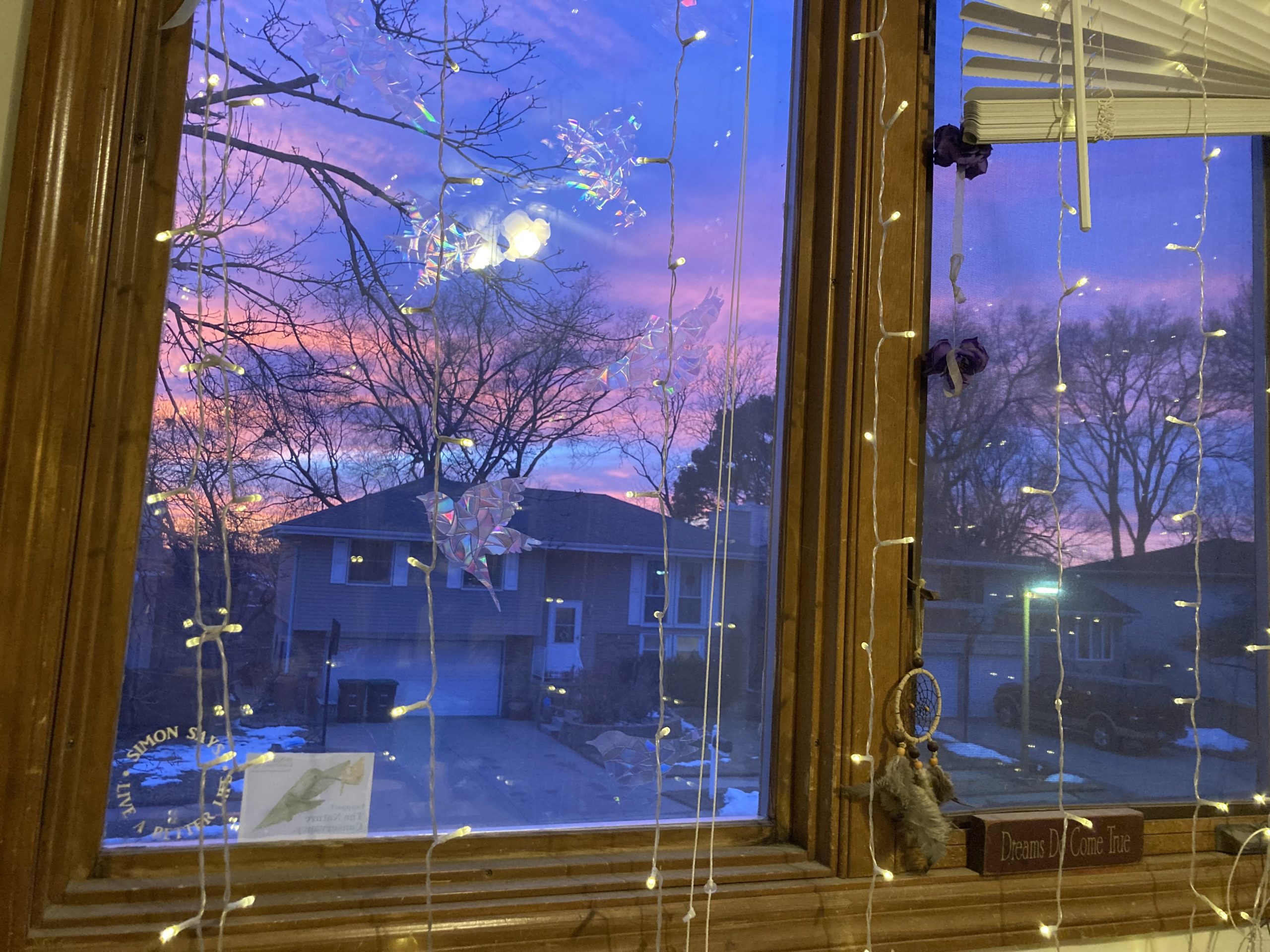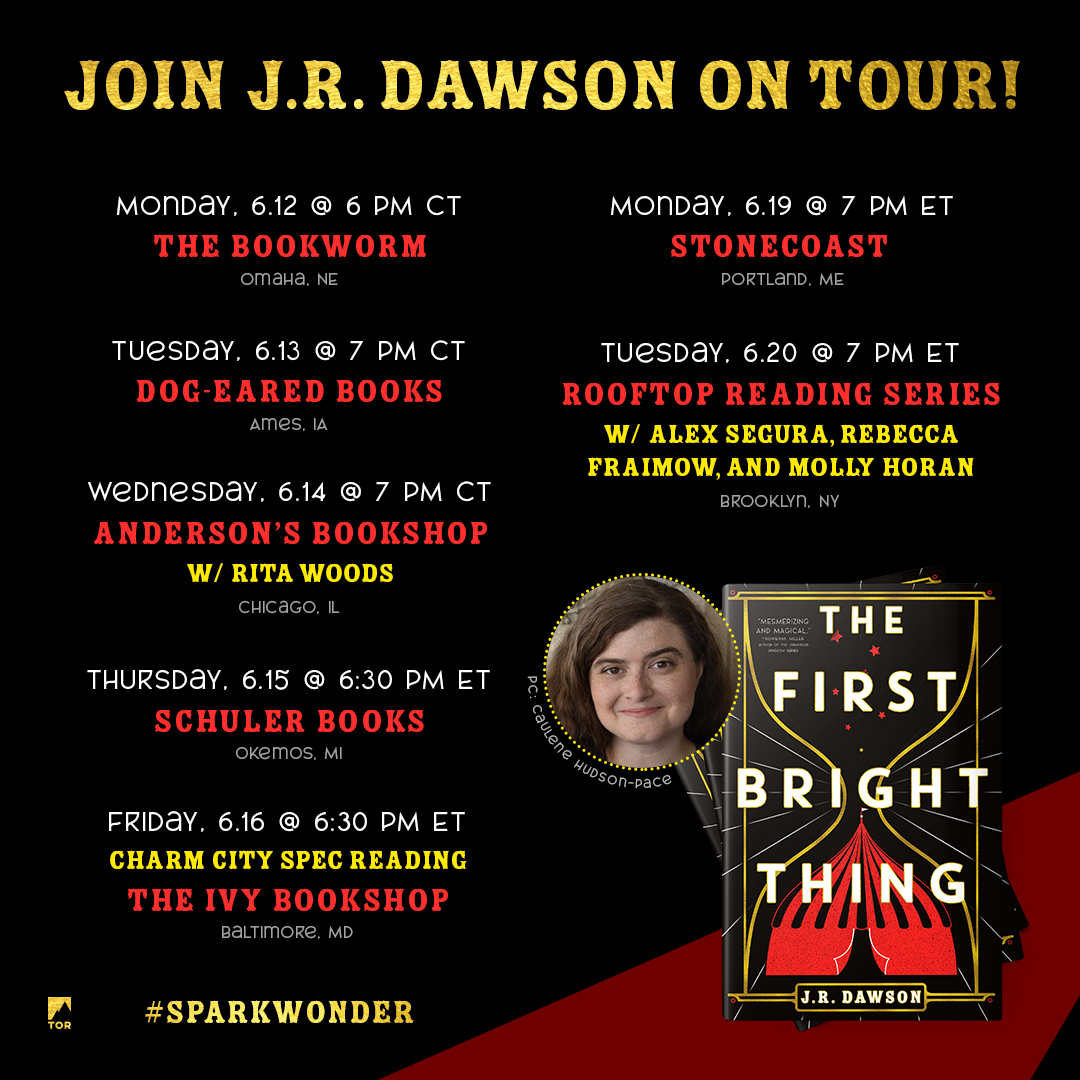6.11.23 J.R. Dawson takes us to the circus with debut novel ‘The First Bright Thing’
J.R. Dawson does really seem to like the circus. That’s evident in her debut novel, The First Bright Thing, about a big top that creates a safe space for artists, time jumping, and a dark threat looming on the horizon. But that wasn’t my only clue; J.R. and I met for the first time during the pandemic lockdown as part of a group that performed classic movies virtually via Zoom (for our entertainment, and no others). The group still exists today, and it does operate as a kind of circus, with a number of ringmasters. But J.R.’s talents expand beyond Zoom movies and circuses; she’s a writer and educator who’s published shorter works in outlets including Fantasy and Science Fiction, The Year’s Best Science Fiction and Fantasty (2018); and Lightspeed. She’s been living in Omaha, Nebraska but has plans to relocate along with her loving spouse and three dogs.
First Bright Thing publishes from Tor on June 13, and she’ll be on a book tour from the 12th to the 20th, starting in Omaha and ending in New York. (If you read this blog frequently, the New York date might seem a bit familiar!) Assuming the role of ringmaster, I shot out a few questions via email for J.R. (also known as Jen) — and here’s how our (still virtual!) conversation went:
Congrats on your debut novel release! For those who may read this but don’t know who you are, explain yourself!
I’m Jen, a queer Jewish writer who loves dogs and lives in Omaha, Nebraska. I’ve published short stories before this, but this is my first novel!
Everyone always wants to know where the idea for the book came from, but what do you think was the first nascent inkling of a thought you had – that turned into this book?
That’s such a good question. I know there were a lot of moments that culminated into this book. In the book’s acknowledgments I talk about the trapeze swinger I saw when I was a kid. But one of the other more surprising ones was Ben Cooper’s music (Radical Face). He wrote a three-album family saga spanning generations and historical instruments. His “Family Tree” was something that stuck with me in the early 2010s, and I always wanted to write my own version of my own home, just like he had.
Is the Holocaust in any way a factor in this book, direct or indirect? How did you want to handle that aspect?
The Holocaust is a major factor in the book, but as a Holocaust educator, it was very important that the Shoah be presented in a very real way that wasn’t voyeuristic or “feel-good” and centered a Jewish narrative. It was more important to me to protect Jewish readers from scenes we’ve seen over and over again and we know by heart. I spoke at WorldCon this past year about this; how to write historically accurate depictions of global trauma/generational trauma/community trauma without being triggering to the victims/survivors. This is something you learn, being around survivors and their families, talking to third generation family members who never saw the inside of a camp but know it well. “Krypton was a shtetl in Poland,” Art Spiegelman said, when he was speaking to Kentucky students about the school bans on his book Maus. The trauma is still there. We know what is on the other end of those trucks that pull away. So yes, long answer short, it is very direct. But no, we don’t enter a camp.
 Are you a fan of a circus, which is a focal point of the book?
Are you a fan of a circus, which is a focal point of the book?
I do love a good, ethical circus. There is a very long discussion to be had about the history of circuses, why they existed, where they came from, who was being exploited. I saw my first circus in the very early 90’s. There’s a picture of me walking to get all the autographs from Clown Alley. I am very wee. And very brave for facing down that many clowns. But that circus also had elephant rides, camel rides, lions in cages, etc. One of my biggest things that I wanted to address in Windy Van Hooten’s was that anyone who could not consent would not be allowed to join. This means they have a shapeshifter instead of live animals. That was the first Spark I created for the circus. Then I wanted to make rules for joining, that if there was literally anything else that a person wanted to do, the circus would help them do it.
What was the first circus you attended, and what stuck with you about it?
My best memory of a circus, the one I talk about in the book, was in this little family circus that parked itself between two roller coasters in Iowa every summer. We stepped inside, it was like stepping back through time. Wood chips on the floor, popcorn, the old spotlights … and oh my God the trapeze swinger did her thing and I was like, “Oh, so magic really does exist.” And I knew that was going to come back in some form later on down the line in my writing.
Circuses are both metaphor and, these days, somewhat falling out of fashion. Do we still need circuses? Why?
Another very good question. And it’s a nuanced answer. So there’s a literally and a metaphorically. Literally, do we need the circus the way it historically has been? Absolutely not. Circuses started as traveling zoos, so people who didn’t live in a big city could see “exhibitions of the world.” This came from the tradition of the World’s Fair. It was a way to show animals to people who had never seen a lion and never would if it wasn’t for the circus (for better or for worse). But there was so much exploitation. And not just for the animals. A bad circus would mean that people were not holding their own agency over their acts, not being given basic human freedoms. I’ve seen since the shuttering of the animal-based circuses, the circus has come back as something new. A lot of “water circuses” have sprouted up. Cirque du Soleil doesn’t use animals or sideshows. I think the art form is shifting and transforming with the times. So that’s hopeful?
Metaphorically, it depends on what a circus is symbolically to you. To me, I try to see it as an art form and a gathering place. It’s got some magic to it. But it’s a complicated answer because the magic can sometimes cover up some real sad stuff. It also can empower. So I guess we’ll see where the future takes us!
The tag line on the book according to your website at Macmillan Publishers is, “If you knew how dark tomorrow would be, what would you do with today?” What’s your answer to that question?
I think my answer to that question is “write this book.” I did all my major edits during the pandemic and I wrote most of it during our 2016-2020 presidency. I didn’t feel safe, so I made a space that was safe. Even if it was just in my imagination. And then I had the goal of sharing that space and saying out to the world, “Hey, we’re not alone. There’s gotta be hope.” I also think that in my personal life, with all these scary things happening all around us, I try to take one day at a time. Enjoy the now. Because tomorrow is not today.
Your characters – Rin and Odette and the Circus of the Fantasticals: Where do they stem from? What do they represent to you?
They stem from the love I have been so lucky to have found in my community. Every time there has been a hard moment in my life, the beautiful, brilliant found family of artists are there to raise me up, and I have the privilege of being there for them. There’s this long historical line of us misfits looking out for each other. Those of us who don’t fit in what a culture wants us to be … family can look very different than what people first think. My family is made of my spouse, my dogs, my best friends and their kids and partners, the memories of those who I have loved who are now passed on … family is such a sacred thing, especially in marginalized spaces.
This is a book about not just a circus and history, but about creativity and artists. Why do those subjects fuel your imagination?
I grew up in the theater. It’s my whole life. It’s the reason so many of us get up in the morning. And there’s magic in what we do, even when it feels so useless and small. We keep doing it. And it keeps changing things. Even if it just changes us, who made it. And my God, artists are the best people. Artists are not only creative in their work, but also in their lives and in their love and friendship and fashion and choice of oven mitts. Artists are my family.
Tell me a little bit about the space where you work. What do you need to really get to work as an author?
I am lucky enough to have a room with a door. I made it my own. It has multiple places to work, it has light, it has painted flowers and prayers … it’s got everything I need. Unfortunately, we’re moving soon, so I’m not exactly sure what my next writing space will look like. In order to get to work, I need music. I can’t write without music. And a pop. And some water. And something comfy to wear.
Where does the title of your book come from?
We had a long list of titles, and the one that was pulled from the description of Rin walking into the dusty tent … that just fit so well.
Is there a “Second Bright Thing” in the future?
The First Bright Thing is a standalone novel, but I have an outline for a sequel. I really love that outline. I don’t know if the world needs it, I guess we’ll see! My biggest hope is that The First Bright Thing finds its audience and people embrace it and we can chat about it. Honestly, if someone home brewed a Funko Pop I’d be happy.
The First Bright Thing can be found on Amazon, Barnes & Noble, Powell’s and other great locations. You can find J.R. Dawson on her book tour below:


